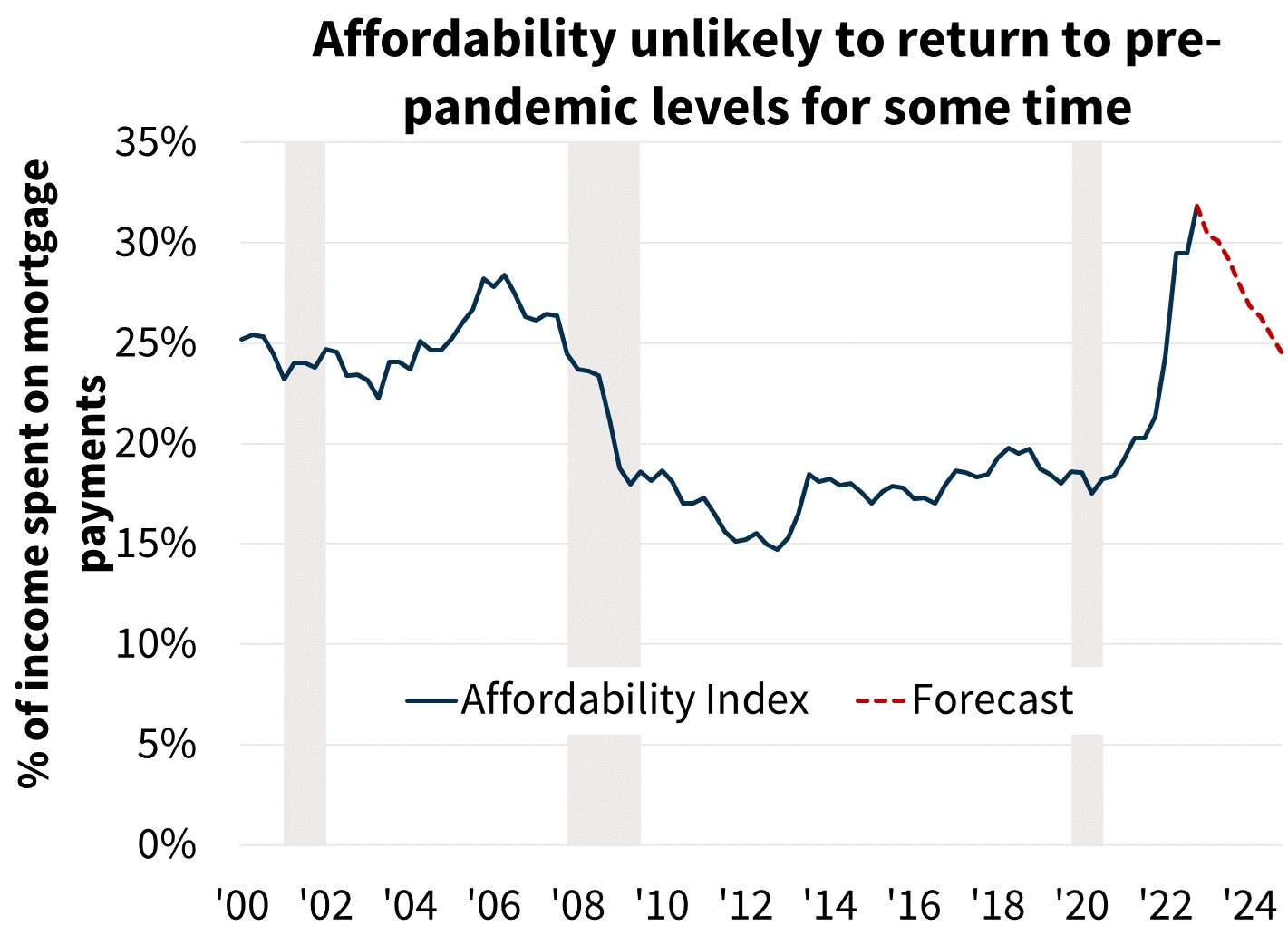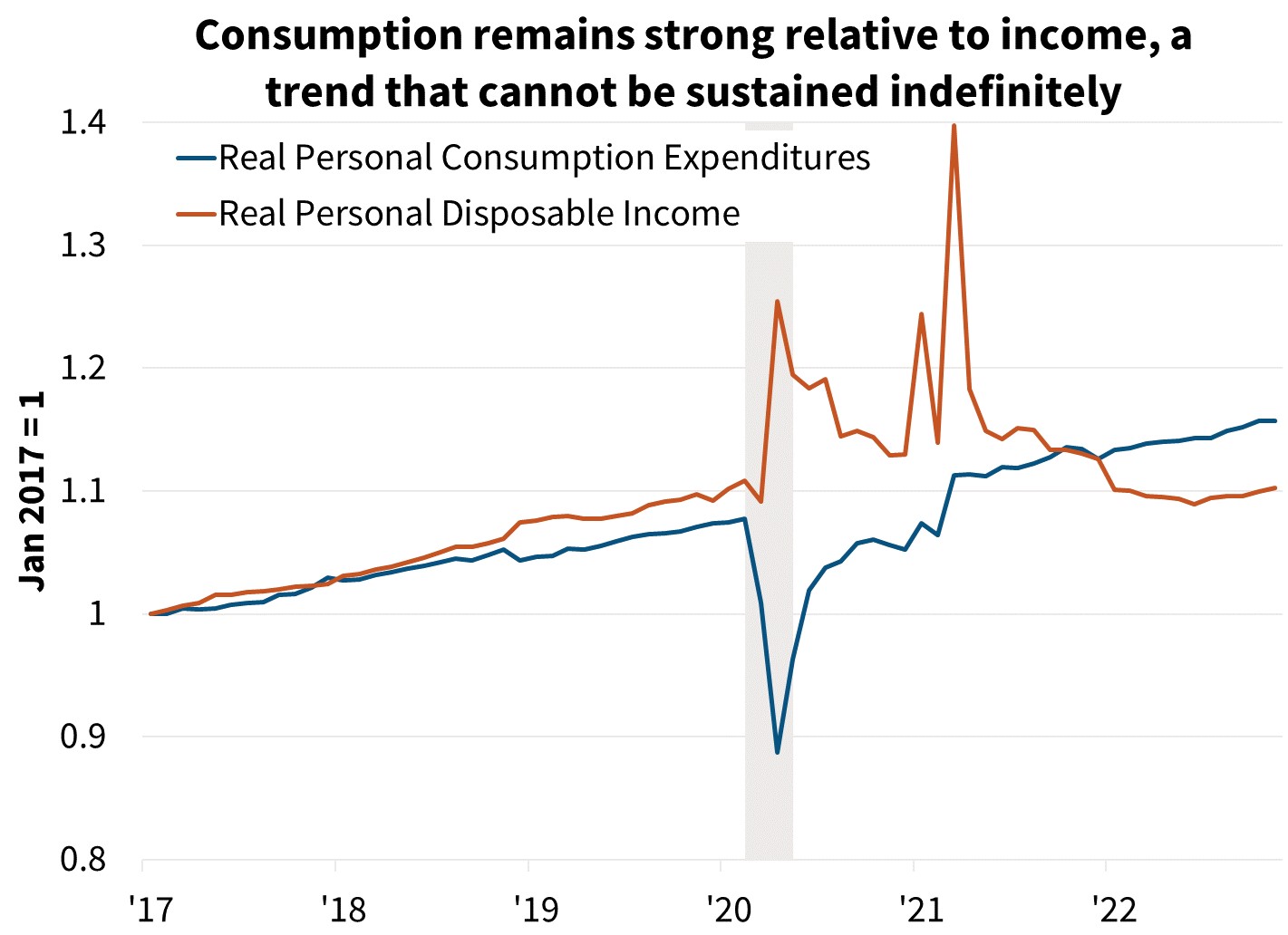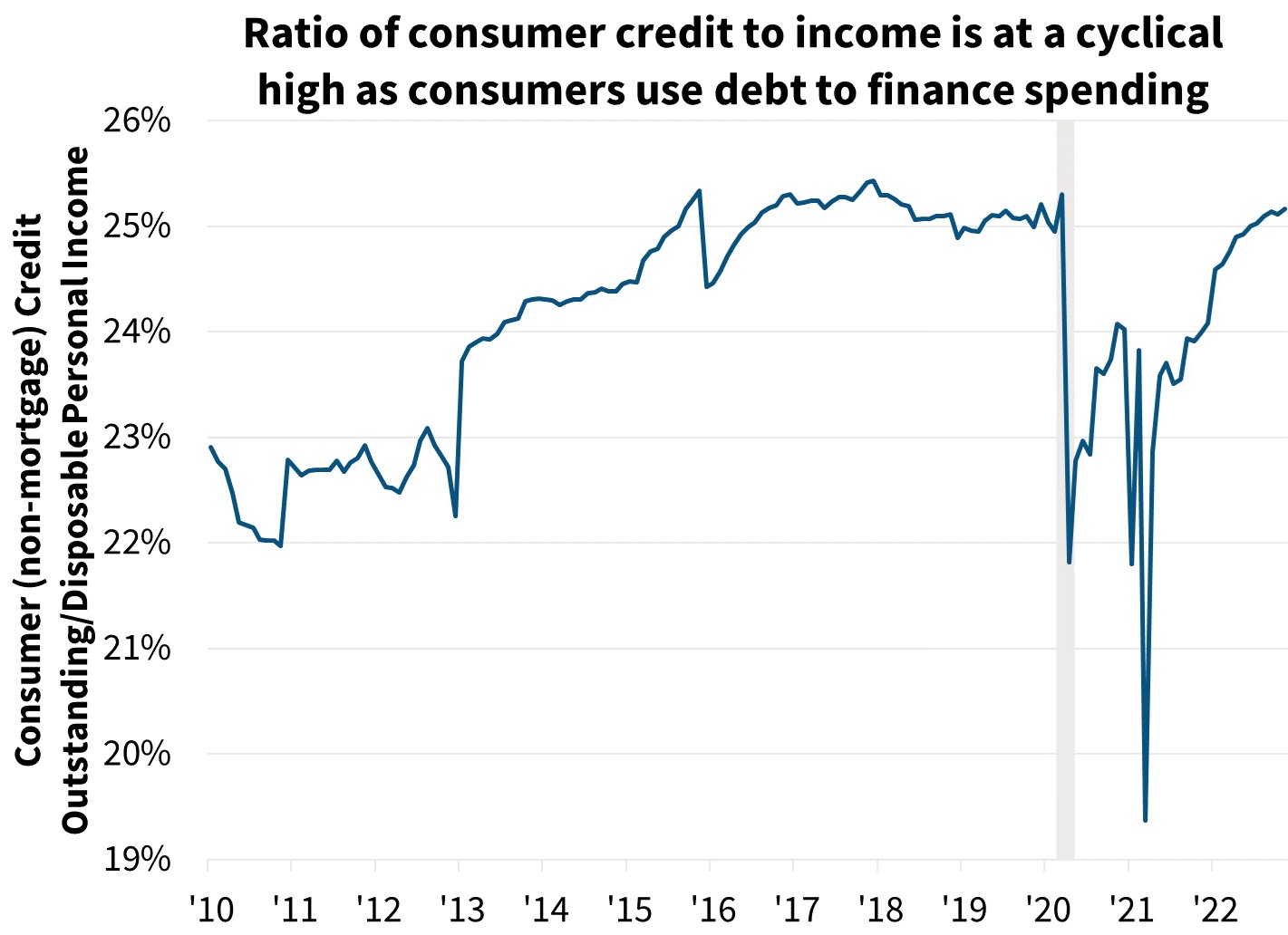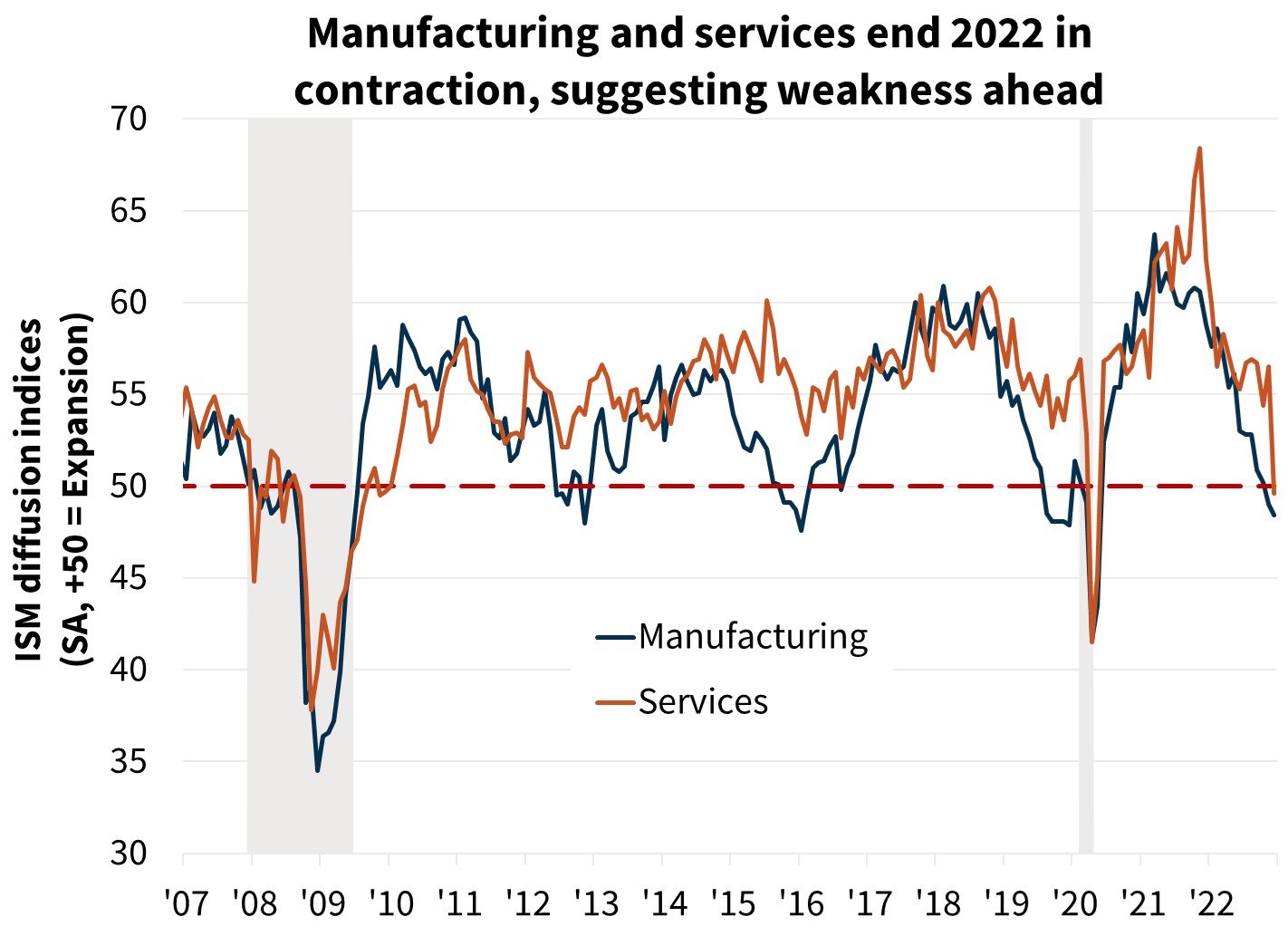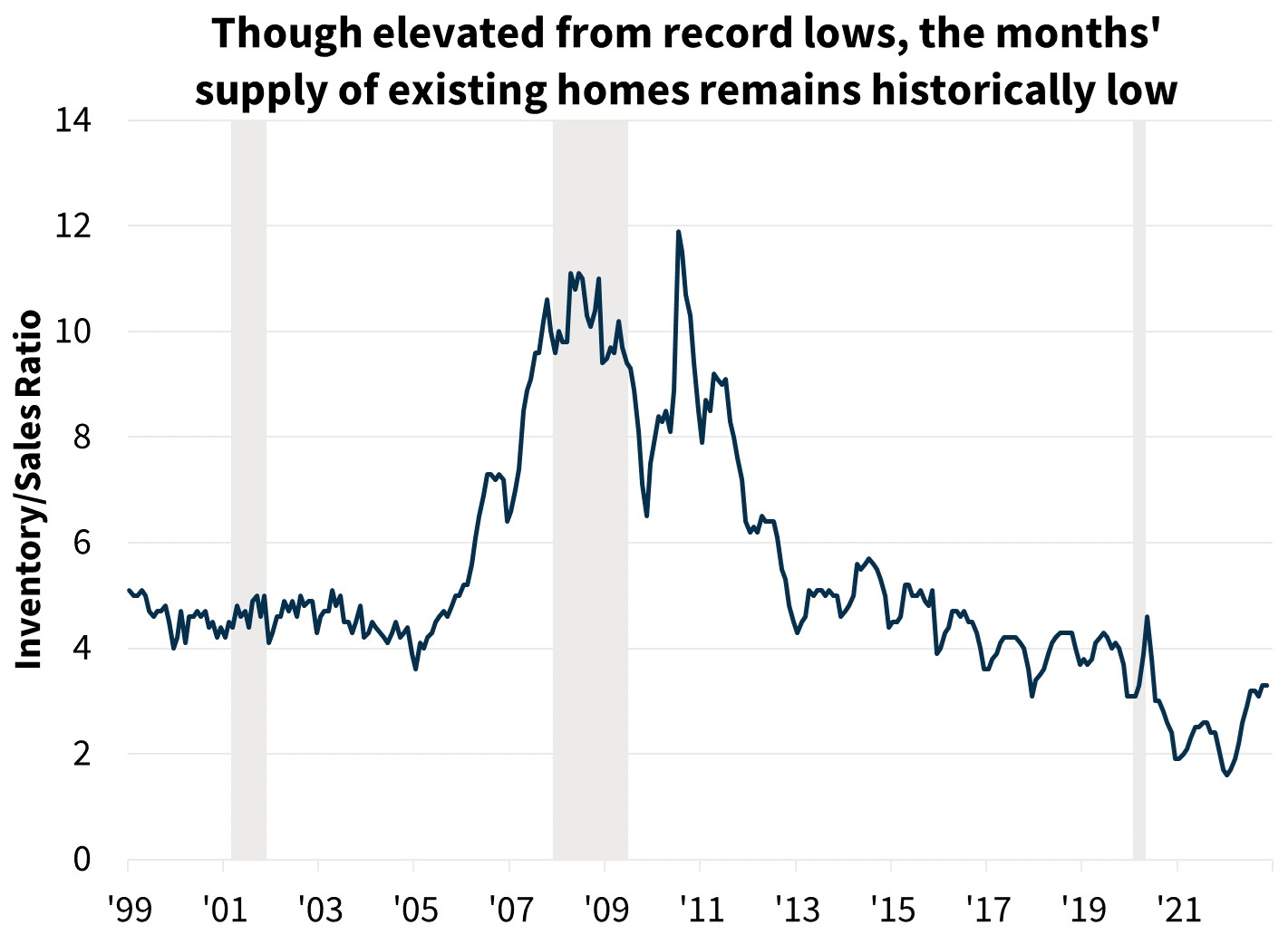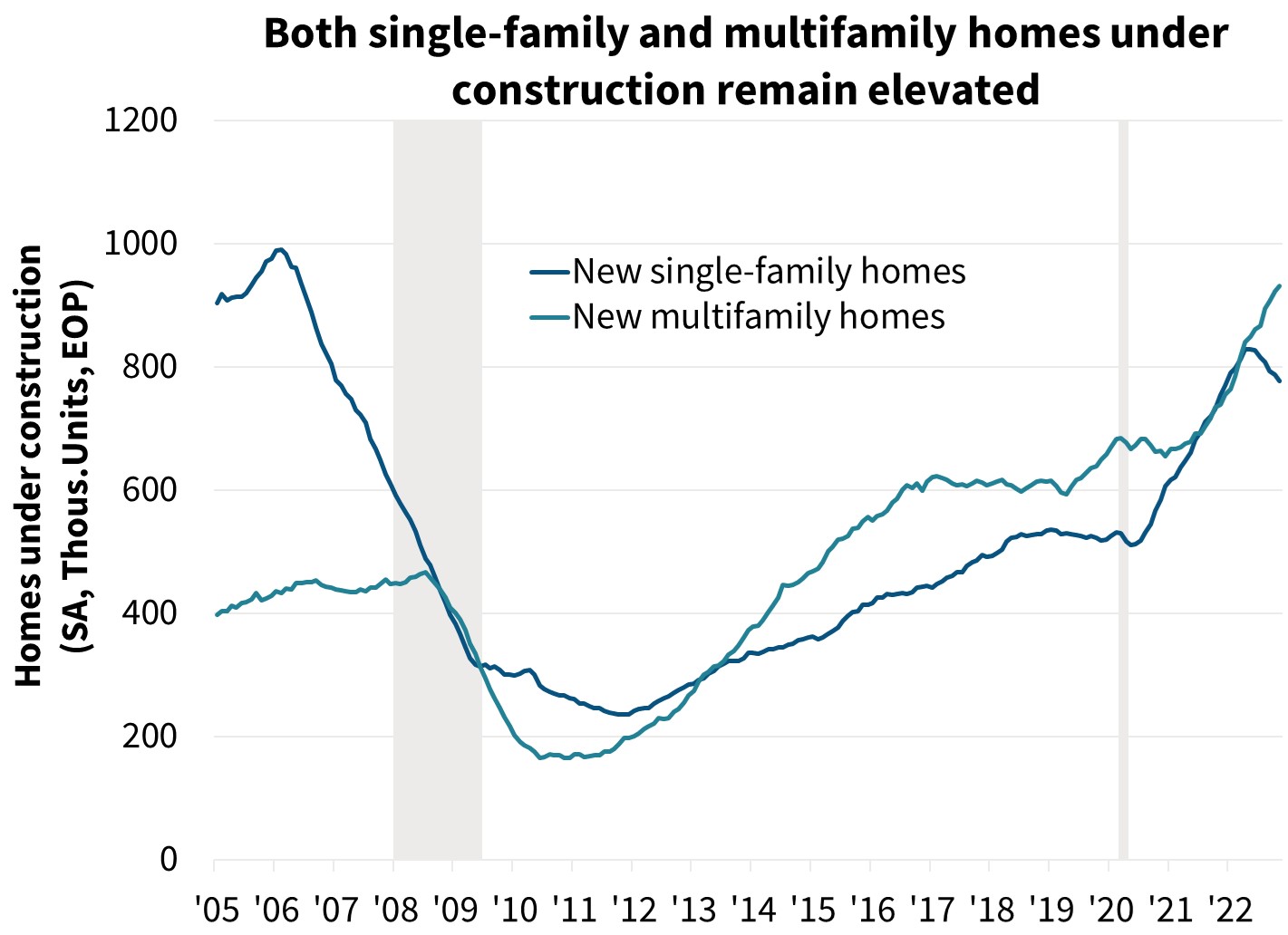Awaiting Improvement in Affordability
This year is expected to manifest an ongoing correction in housing market affordability as we expect household incomes and housing costs to gradually approach a more sustainable relationship. We project that the combination of declining home prices, lower mortgage rates, and, with time, growing household incomes, will eventually place the housing market in a recovery. The same dynamic holds for rents. However, we believe this process is likely to take multiple years.
We have revised upward our final 2022 GDP growth estimate to 0.8 percent from 0.4 percent on a Q4/Q4 basis due to sizable data revisions and stronger incoming indicators. While the year now appears to have ended on a stronger footing than previously anticipated, we continue to expect a modest recession to begin during the first half of the year and are forecasting Q4/Q4 GDP growth for 2023 to be negative 0.6 percent, a tick down from our previous forecast.
We have revised downward our forecast for home price growth to a decline of 4.2 percent in 2023 on a Q4/Q4 basis, followed by a further drop of 2.3 percent in 2024. These figures are down from a previous forecast of 1.5 percent and 1.4 percent declines, respectively. As measured by the Fannie Mae Home Price Index, cumulatively through the end of 2024, we project prices to fall 6.7 percent over the next two years.
We expect home sales to remain subdued for the remainder of 2023. We now forecast total home sales in 2023 to be 4.52 million units, a 21.3 percent decline from our final estimate of 2022 total sales, and the slowest annual pace since 2010. We forecast a partial rebound in 2024 to follow, with total sales rising 12.8 percent to 5.1 million units on the back of the economic recovery. This is a pace still well below recent years as affordability challenges remain elevated. Our outlook for overall single-family mortgage originations in 2023 is $1.64 trillion and $1.97 trillion in 2024, a substantial contraction from volumes in 2022 that we estimate at $2.34 trillion.
2022 Growth Was Stronger Than Expected, but Recession Still Likely to Begin in First Half of 202
An upwardly revised Q3 2022 GDP figure and stronger-than-expected incoming data on business inventories and private fixed investment point to 2022 having ended with stronger growth than previously expected and led to an upgrade to our final 2022 growth estimate. Still, similar to how GDP readings in the first half of 2022 understated the underlying trend in the economy’s growth due to unusually sharp swings in net exports and business inventory investment, a reversal in the same trends in the second half of the year likely overstates the economy’s true strength.
Consumer spending remains unsustainably high relative to disposable income, supported by consumers tapping into savings built-up during the pandemic period and taking on debt. While it is difficult to determine the exact timing, we believe it is only a matter of time before consumer retrenchment helps drive an eventual general economic contraction. The personal saving rate rose from to 2.2 percent to 2.4 percent in November but remained near the record low of 2.1 percent set in 2005 (compared to a typical range of 7 to 9 percent pre-COVID). Outstanding consumer debt as a share of disposable income is also now hitting new cyclical highs and credit performance measures are starting to weaken. Lastly, declining home values, and a growing perception on the part of households of future declines being likely, as evidenced in the Fannie Mae National Housing Survey®, suggest that wealth effect-driven consumption will also be more limited going forward. Beyond housing, higher interest rates on consumer loans will likely discourage some consumers from purchasing big-ticket items such as cars and home appliances. While the fall in energy prices in recent months provided some relief on inflation and helped to bolster real income growth at the close of 2022, it is notable that real personal consumption growth in November was modest relative to income gains, which suggests a more reserved consumer moving forward.
The continued strength in the labor market points to an economy not yet in contraction, but we believe a recession is still likely to begin in the first half of 2023 based on ongoing weakness in leading economic indicators, the consumer spending outlook discussed above, and early signs of softening in the labor market. While the level of payroll gains remains relatively robust, those gains have decelerated modestly in each of the past five months. Further, while labor in general is a lagging indicator, an historical leading indicator of the labor market is employment of temporary workers. Over the past four months ending in December, temporary help services have shed an average of more than 27,000 jobs per month, a notable turn from an average addition of roughly 6,000 jobs in the four months prior ending in August and an average of more than 25,000 net additions per month in 2021. In addition, while still at low levels, continuing unemployment claims have generally trended upward in recent months and meaningful movement off of a cyclical bottom in this measure has historically indicated a broader economic downturn is approaching.
The severely inverted yield curve and the Conference Board’s Leading Economic Index® both continue to point to a downturn approaching. Additionally, the highly cyclical manufacturing sector has slowed, with the Institute for Supply Management (ISM) Manufacturing Index in contractionary territory for the second consecutive month in December and the new orders subcomponent suggesting further weakness ahead. Of note, the service sector ISM index also fell sharply in December, declining below the expansionary threshold for the first time since the COVID outbreak.
Interest Rate Expectations Pulling Back as Inflation Decelerates
The December CPI report was the third consecutive reading pointing to softening of inflationary pressure. While the 0.1 percent decline in the headline index was due in part to a sharp drop in gasoline prices unlikely to be repeated in January, the core index was also more subdued than earlier in the year, rising 0.3 percent over the month and decelerating on an annual basis to 5.7 percent from 6.0 percent. Combined with a large downward revision to recent hourly wage growth data in the December employment report, there is growing indication that inflationary pressures, while still present, are cooling.
In this context, market expectations of future short-term interest rates are increasingly deviating from the most recent Fed Summary of Economic Projections, with the market anticipating an earlier end to additional rate hikes and even rate cuts to occur sometime later this year. We see market expectations as being more consistent with our forecasted recession, and we expect that we are currently nearing the terminal fed funds rate. However, if a recession is delayed or even outright avoided, or inflation indicators cease improving, then there is a risk that monetary policy remains tighter for longer, which may translate into higher longer-term interest rates as markets discount any near-term return to below-neutral levels of short-term rates. While continued economic growth would be supportive of housing, this also leads to a risk of higher mortgage rates and therefore would impact our home sales and home price outlook.
Weak Home Sales Expected as Home Prices Readjust
While we are forecasting sizable home price declines over the coming two years, we do not expect a repeat of the Great Financial Crisis. Due to the minimal use of adjustable-rate mortgages (ARMs), teaser rates, and exotic mortgage products, a relatively small portion of current single-family borrowers are subject to payment shocks from this past year’s rising interest rates in the way many borrowers were in 2006-2008. We believe this factor, combined with more robust underwriting standards and a stronger set of tools available for loan workouts and modifications compared to the housing crisis of 2008, will mitigate the impact of home price declines on mortgage delinquencies and foreclosures. Additionally, both residential real estate in aggregate and the overall financial system are less leveraged than they were prior to the past crisis, allowing more room to absorb credit losses that may occur from declining home prices. In summary, we do not foresee further downward pressure on home prices as a result of a large number of homes being added to the market through distressed sales and foreclosures. Therefore, we believe the spillover effects from housing into the macroeconomy will likely be more limited.
On a more fundamental level, the supply of existing homes for sale remains tight, and we continue to believe the overall housing stock is well below what long-run demographic trends suggest is needed. Thus, we do not anticipate an overabundance of properties on the market leading to disorderly home price declines. Rather, we expect an environment of weaker sales to continue along with gradual home price declines until affordability measures approach more sustainable levels, which would then lead to a recovery in transactions. We expect that existing home sales dipped below 4 million annualized units in December and anticipate a sub-4 million pace to continue through most of 2023.
The tight existing market for homes should help bolster sales of new homes, comparatively speaking. With many existing owners disincentivized to list their homes for sale and move due to “lock-in” effects, by which existing owners have mortgages with rates well below current market rates, as well as overall affordability challenges, first-time buyers have increasingly turned to new homes. A significant number of single-family homes remain under construction (777,000 as of November), and homebuilders continue to operate at margins allowing for additional price concessions and incentives to bolster sales of these units as needed. Homebuilders have increasingly turned to buying down points on homebuyers’ mortgages, for example. As more homebuilders work through their current order backlogs, we would expect more aggressive use of this tool and other incentives to drive sales.
Therefore, unlike past housing cycles, when new home sales and construction tended to decline more than existing home sales, we are anticipating the new home sales market to remain somewhat resilient. Meanwhile, the addition of more completed new units to the market will be one of the mechanisms putting downward pressure on existing home prices. We forecast new home sales to decline in 2023 to 570,000 annualized units, down 12.7 percent from year total 2022 levels compared to a decline in existing sales of 22.4 percent. However, this still represents a new home sales pace only modestly below the pre-COVID norm.
In our view, affordability will not improve over time solely through home price declines. We are anticipating that mortgage rates will drift downward over our forecast horizon, ending 2023 a little above 6 percent and 2024 around 5.5 percent. Regardless of where longer-term interest rates ultimately settle, the spread between the 10-year Treasury rate and the 30-year mortgage rate continues to be historically elevated at around 280 basis points as of this writing. We expect this spread to compress over the next couple of years toward a more historically normal 190 basis points as interest rate volatility diminishes and Fed policy tightening ceases.
Lastly, in part due to the elevated level of inflation entering our anticipated economic downturn, and in part because we are expecting the magnitude of the contraction to be modest, we believe nominal income growth is likely to be stronger in aggregate over the next few years compared to what occurred over recent business cycles. Some of the housing affordability convergence in coming years will be accomplished through rising household incomes, lowering the degree of home price declines necessary to arrive at a sustainable relationship.
In a recession, multifamily rents typically experience short-term contractions, though the degree of the contractions has varied over the past several recessions. Contractions were much more significant during the 2008 recession, when unemployment reached 10 percent, compared to the 2001 recession when unemployment only increased to 6 percent. Multifamily housing, too, has a historically large number of units currently under construction and upon completion will also contribute to softening rents and home price growth, via making renting comparatively more attractive in rent vs. buy decisions. While this is part of the affordability improvement picture, we expect multifamily construction starts to slow meaningfully this year in light of softening rents and rising vacancy rates along with more expensive financing costs.
Weaker Mortgage Originations on Lower Sales and Home Prices
Revisions this month to our forecast for single-family mortgage originations were largely driven by our downgraded home price outlook. In particular, we now expect $1.6 trillion in origination volume in 2023, a $61 billion downgrade from last month’s forecast and a 30 percent year-over-year decline. Origination volume is then expected to grow by 20 percent in 2024 to $1.97 trillion as the housing market begins to recover and rates gradually fall. We expect purchase volumes to fall 23 percent in 2023 to $1.28 trillion, a downward revision of $51 billion from last month’s forecast corresponding to the weaker home price expectation, as well as lower projected home sales. Purchase volumes are then expected to grow by 11 percent in 2024 to $1.42 trillion as the housing market begins to recover, though by a slower pace than we had previously expected.
Our forecast for refinance originations was also revised downward this month due primarily to the lower home price expectation, which mainly impacts cash-out refinances. We now expect refinance volumes to be $683 billion in 2022 and $356 billion in 2023, both slight downward revisions from last month’s forecast. In 2024, we expect refi volumes to rebound to $545 billion as mortgage rates gradually decline.
Economic & Strategic Research (ESR) Group
January 13, 2023
For a snapshot of macroeconomic and housing data between the monthly forecasts, please read ESR’s Economic and Housing Weekly Notes.
Data sources for charts: Bureau of Economic Analysis, Bureau of Labor Statistics, Federal Reserve, Fannie Mae, Realtor.com
Opinions, analyses, estimates, forecasts and other views of Fannie Mae's Economic & Strategic Research (ESR) Group included in these materials should not be construed as indicating Fannie Mae's business prospects or expected results, are based on a number of assumptions, and are subject to change without notice. How this information affects Fannie Mae will depend on many factors. Although the ESR group bases its opinions, analyses, estimates, forecasts and other views on information it considers reliable, it does not guarantee that the information provided in these materials is accurate, current or suitable for any particular purpose. Changes in the assumptions or the information underlying these views could produce materially different results. The analyses, opinions, estimates, forecasts and other views published by the ESR group represent the views of that group as of the date indicated and do not necessarily represent the views of Fannie Mae or its management.
ESR Macroeconomic Forecast Team
- Doug Duncan, SVP and Chief Economist
- Mark Palim, VP and Deputy Chief Economist
- Eric Brescia, Economics Manager
- Nick Embrey, Economist
- Nathaniel Drake, Economic Analyst
- Richard Goyette, Economic Analyst
